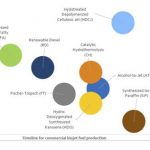 |
| Reviews and Templates for Expression We |
Biojet Fuels Key to Aviation Emission Cuts, Report Says

Biojet fuels will be key to achieving the aviation industry’s pledge to cut CO2 emissions to 0.2 billion tons (GT) in 2050 — half the 2005 figure — as opposed to the 2.1 GT projected by current growth rates, according to Lux Research.
Biojet fuel innovations, led globally by Honeywell UOP and Boeing, will account for 56 percent of the targeted CO2 emissions reductions, while a third of the cuts will come from new aircraft technology, and optimization of operations and infrastructure, the report says.
“In the estimated $300 billion jet fuel market in 2050, Neste and Honeywell UOP will be winners over the short term, while renewable diesel producers UPM and Renewable Energy Group will be mid-term winners, and companies like Ensyn and Licella, will be long-term winners,” said Yuan-Sheng Yu, Lux Research Analyst and lead author of the report, Biojet Fuel Technology Roadmap.
The first-ever global emissions standard for commercial aircraft is expected to be approved later this year by the United Nation’s aviation body, the International Civil Aviation Organization.
Lux Research analysts studied the biojet fuel landscape against 2050 targets for CO2 emissions, and evaluated the main companies involved in the development of novel fuel types. Among their findings:
- Technology shifts over time. Of the four ASTM-certified pathways for biojet fuel, and an additional four under review, HEFA, or hydroprocessed esters and fatty acids, is the only viable short-term option while HDCJ, or hydrotreated depolymerized cellulosic jet, will be the long-term winner.
- Honeywell UOP and Boeing are global flag-bearers. Honeywell UOP and Boeing are the undisputed global leaders since the CAAFI biojet initiative was launched in 2006. Honeywell has 333 unique relationships and 13 different initiatives, and with AltAir, operates the first commercial-scale biojet fuel plant. Boeing has established 279 unique ties and 20 initiatives, and has focus on Japan, United Arab Emirates and Mexico.
- Aircraft and other innovations matter. New aircraft models using lightweight materials have been instrumental in 1.5 percent annual fuel efficiency improvements since 2010. Other measures that will help the industry include lightweight cabin gear, seat design, taxiing on one engine, scheduling of flights in optimal conditions and improved air traffic controls.
The biojet fuel report follows an earlier report by Lux Research that says big oil’s dominance in the transportation fuel market — jet fuels, diesel and gasoline — is coming to an end under threat from alternative fuels and battery technologies.
|
|
|
|
Copyright remains with the original authors |